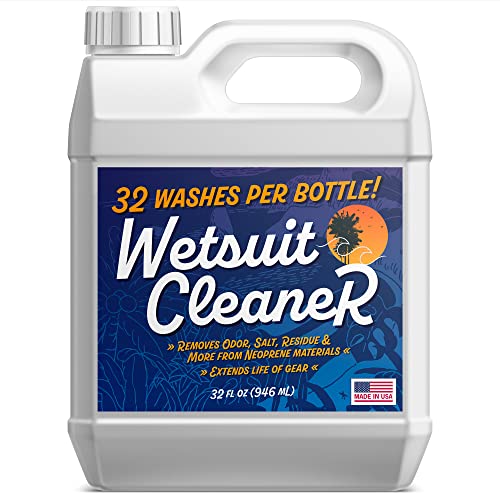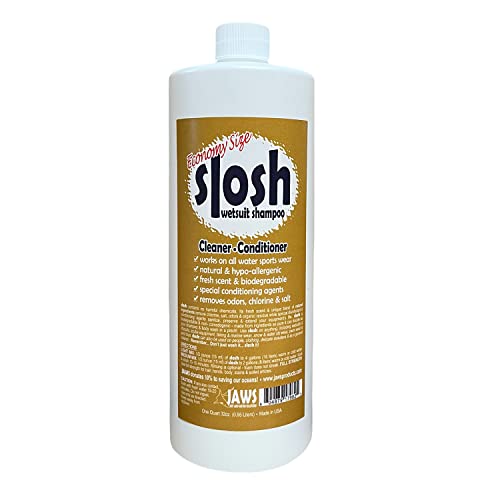Your wetsuit plays an important role in keeping you comfortable and protected during your underwater adventures, so you want to make sure that it stays in excellent condition. Since you have already spent a substantial amount of money on it, you want it to continue serving its purpose for many years to come.
But where exactly do you start?
In this blog post, I will guide you on how to care for your scuba diving wetsuit. I have learned these from fellow scuba divers and have also tried and tested them for myself.
If you bought your scuba diving gear for the first time, and want to learn how to properly clean, dry, and store your wetsuit, then you’ve come to the right place.
By following these tips on wetsuit care and maintenance, you can preserve your dive equipment‘s functionality, extend its lifespan and enhance your overall diving experience.
Continue reading for some of the top wetsuit best practices for scuba diver.
1. Rinse your wetsuit with fresh water
Taking care of your wetsuit is essential for preserving its quality and durability. While it may be tempting to forgo the cleaning process after a fantastic dive, rinsing your wetsuit is critical. Make it a habit to completely clean your wetsuit with fresh water after each dive to eliminate any saltwater, sand, or debris that has gathered.
This simple process aids in the preservation of the neoprene material. Saltwater left to dry on the suit can reduce its flexibility and integrity. Rinsing your wetsuit on a regular basis preserves its elasticity, color, and overall quality, ensuring it remains functional and long-lasting.
Fill a bucket with fresh water or use a hose if one is available to rinse your wetsuit. Rinse the interior and exterior of the wetsuit completely, paying special attention to areas where sand and debris may have accumulated. Never use hot water to rinse or clean your wetsuit.
Proper rinsing also removed sweat, oils, and bacteria that cause unwanted orders and skin irritation and infections. By removing these, you can keep your wetsuit clean and fresh.
2. Use a wetsuit mat
Rinsing your wetsuit is not the only way to care for it. To reduce the quantity of sand and grime that clings to your wetsuit, consider using a wetsuit mat or changing on a clean surface. This reduces wear and tear on the cloth, extending its life.
A wetsuit mat is a valuable accessory that aids in maintaining and protecting your wetsuit. Made from a durable, waterproof material, the mat provides a clean and stable surface for changing in and out of your wetsuit. Wetsuit mats are waterproof, keeping your wetsuit dry and preventing it from getting dirty when changing in wet or muddy areas.
3. Avoid peeing in your wetsuit
While it may be tempting to relieve oneself while diving, urine can produce offensive odors and encourage bacterial growth. To keep your wetsuit fresh and odor-free, use the restroom before putting it on.
Of course, there may be some instances where you can’t help but pee in your wetsuit. So when it happens, make sure to just give it a good rinsing after.
4. Use a wetsuit Cleaner
To ensure a thorough clean, consider incorporating a wetsuit cleaner into your maintenance routine. This extra step can help eliminate bacteria and other unwanted matter that regular rinsing may not remove completely, keeping your wetsuit fresh and odor-free.
Avoid harsh detergents or bleach, as they can harm the neoprene material. Instead, after rinsing your wetsuit with fresh water, fill a basin or bathtub with cool water and add the recommended amount of wetsuit shampoo.
Gently work the shampoo into the neoprene fabric, paying extra attention to areas with more dirt or grime buildup. Once done, thoroughly rinse the wetsuit with fresh water and hang it to dry in a well-ventilated area, away from direct sunlight.
Using a wetsuit shampoo is unnecessary every time you clean your wetsuit, but it is beneficial to incorporate this step occasionally, especially if you frequently use your wetsuit or dive in environments with a lot of debris or bacteria.
Follow the wetsuit shampoo manufacturer’s recommendations and instructions to avoid damaging the neoprene.
5. Don’t put your wetsuit in the washing machine
It is not recommended to put your wetsuit in a washing machine.
Washing machines can be too harsh for the neoprene material, resulting in damage or premature wear. The machine’s agitation and spinning motion, combined with the detergent and friction, might cause rips, straining, or seam failure.
There are, however, certain exceptions. If the manufacturer expressly labels your wetsuit as machine washable and provides specific instructions for machine washing, you can follow their recommendations.
6. Use A Wetsuit hanger
Wetsuit hangers can be super helpful in your wetsuit cleaning and maintenance routine. It can dramatically extend the lifespan of your wetsuit, maintain its integrity, and ensure it is always ready for your next diving trip.
A wetsuit hanger aids in the reduction of wrinkles and creases, which can impact both the looks and performance of your wetsuit. It helps to keep the shape and fit of your wetsuit by avoiding stretching and distortion.
Wetsuit hangers allow proper ventilation while drying. It limits the formation of mildew and unpleasant odors that flourish in damp environments.
They also offer a practical storage solution, keeping everything tidy and conveniently accessible.
7. Dry your wetsuit properly
After cleaning, gently squeeze out excess water from your wetsuit. Avoid wringing or twisting it, as this can damage the neoprene.
Hang your wetsuit to dry in a well-ventilated area, away from direct sunlight.
Dry your wetsuit inside out to effectively drain any residual water in the suit’s interior. This step is especially important for wetsuits made of thicker neoprene, as the material takes longer to dry completely.
Give the wetsuit enough time to dry completely. This may take several hours or even overnight, depending on the thickness of the neoprene and the ambient conditions. It’s important to ensure the wetsuit is completely dry before storing it to prevent the growth of mold, mildew, and unpleasant odors.
8. Don’t leave Your wetsuit Under The Sun
To protect your wetsuit, it’s best to store it in a cool, dry place away from direct sunlight. If you need to dry your wetsuit, choose a well-ventilated area or shade to ensure proper airflow.
Direct sunlight can destroy the neoprene material. Prolonged heat exposure can cause neoprene to stiffen, brittle, and lose its elasticity. This can lead to diminished flexibility and comfort, reducing the wetsuit’s overall performance.
Sunlight also contains ultraviolet (UV) radiation, which can fade and discolor the colors in your wetsuit overtime. This not only impacts the aesthetic but can also suggest potential structural damage to the neoprene.
9. Avoid excessive heat
Neoprene is a synthetic rubber that is highly sensitive to heat. Aside from the sun, also avoid drying your wetsuit using a machine dryer or direct heat sources, like radiators. Never iron your wetsuit, as this will cause the material to melt, warp, or lose its elasticity.
10. Store your wetsuit properly
To ensure your wetsuit remains in top condition, follow these tips on how to store your wetsuit.
Before storing, make sure your wetsuit is completely dry to avoid molds and mildew growth.
Hang it on a wide hanger or lay it flat to prevent creases and wrinkles. Avoid storing it in cramped spaces or with heavy objects on top that could compromise the neoprene’s integrity.
Avoid excessive folding or compressing of the wetsuit to prevent damage to the neoprene material. Instead, opt for a loose storage method that allows the wetsuit to maintain its natural shape.
Choose a cool, dry storage location like a closet or storage bin away from moisture and heat sources. Find a storage area that avoids high humidity, excessive heat, or extreme temperature fluctuations.
For added protection, consider storing your wetsuit in a container to prevent damage from insects or rodents.
11. Avoid contact with sharp objects
Before putting on your wetsuit, trim your fingernails and toenails. Sharp nails can accidentally puncture the neoprene, leading to tears or holes. Keeping them short reduces the risk of accidental damage.
Be conscious of how your other dive gear interacts with your wetsuit. Adjust and secure your BCD and weight belt carefully to minimize friction. Sharp edges or rough Velcro attachments can cause wear and tear on the wetsuit material.
Be mindful of sharp objects like dive knives or sharp rocks that could puncture or damage your wetsuit. Take extra care when kneeling or sitting on rough surfaces to prevent unnecessary wear and tear.
12. Avoid excessive stretching
When putting on or taking off your wetsuit, be gentle and avoid excessive stretching. Pulling too hard on the material can lead to tears or stress points.
If you have difficulty getting into your wetsuit, you can try wearing dive skins, rashguards or dive leggings. The smooth fabric of these wetsuit undergarments lessens the friction between your body and the neoprene wetsuit. Here are some dive leggings and rash guard recommendation for women that may help reduce friction while gearing up.
Another hack is to cover your feet in plastic as you step into your wetsuit. This makes it easy to glide in your wetsuit’s lower extremities. Don’t forget to remove the plastic before you dive! An alternative for this hack is to wear dive socks.
Putting on or removing your wetsuit while in the water can also help. The water serves as a lubricant between your skin and the suit, so you can easily wear it with ease without having to tug and pull as much.
Seek assistance when necessary. Wetsuits can be come really clingy after a dive so don’t be shy to ask your dive buddy to help you out.
13. Repair Wetsuit damage immediately
Even with careful maintenance, your wetsuit will ultimately show signs of wear and tear. As a result, it’s critical to inspect your suit on a regular basis for any damage that could jeopardize its effectiveness.
Begin by inspecting the seams for fraying or damage. In addition, inspect the zipper for signs of corrosion or damage. Applying a zipper lubricant can help prevent corrosion and make zipping and unzipping your wetsuit easier.
Examine the neoprene material for tears, punctures, and holes. Even minor tears might allow water to soak into your wetsuit, making it less efficient at keeping you warm. You may extend the life of your wetsuit by swiftly addressing minor damages such as small tears or holes with neoprene repair kits. Taking care of these problems keeps them from developing and becoming irreparable, saving you the cost of replacing the entire wetsuit.
If you discover any major problems have your wetsuit repaired by a professional before throwing them out. Repairing your wetsuit contributes to environmentally friendly practices by reducing trash. Extending the life of your wetsuit through repairs minimizes the demand for new wetsuit production, lowering the environmental impact of production and disposal.
14. Follow the manufacturer’s recommendation on how to care for your wetsuit
The tips above are general guidelines on how to take care of your wetsuits. It is always best to check what your wetsuit manufacturer recommends.
Wetsuit makers have extensive knowledge of their products’ materials, construction, and design, so they might provide specific instructions tailored to each wetsuit model. By following their recommended cleaning methods, drying techniques, temperature limits, and storage instructions, you maintain the integrity and functionality of your wetsuit brand and model.
Moreover, complying with the manufacturer’s wetsuit care instructions protects any warranty or guarantee. Failure to follow their recommended wetsuit best practices may void the warranty, leaving you without recourse for defects or issues.
In conclusion, wetsuits can be a significant financial investment, and proper care is important to protect that investment. Incorporating these simple wetsuit maintenance tips will help you get more use out of your gear while simultaneously reducing the amount of money you spend on replacements.
Taking the time to rinse, hang, shampoo, store, and inspect your wetsuit may seem like a small inconvenience, but it’s a small price to pay for a safe and pleasurable diving experience. Your efforts will reward you with a clean, sanitary, and perfectly fitted wetsuit that accompanies you on countless exciting underwater adventures.














